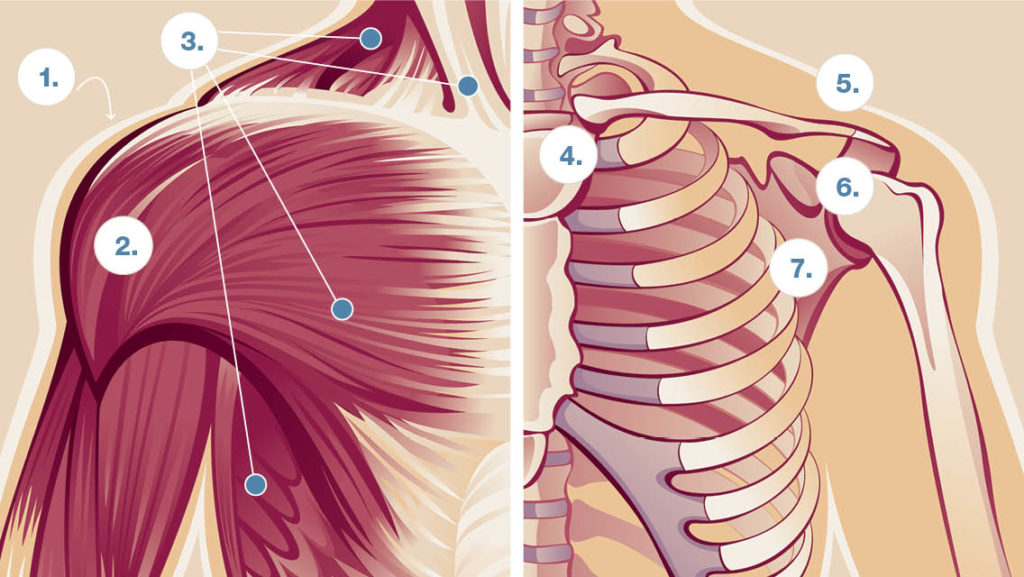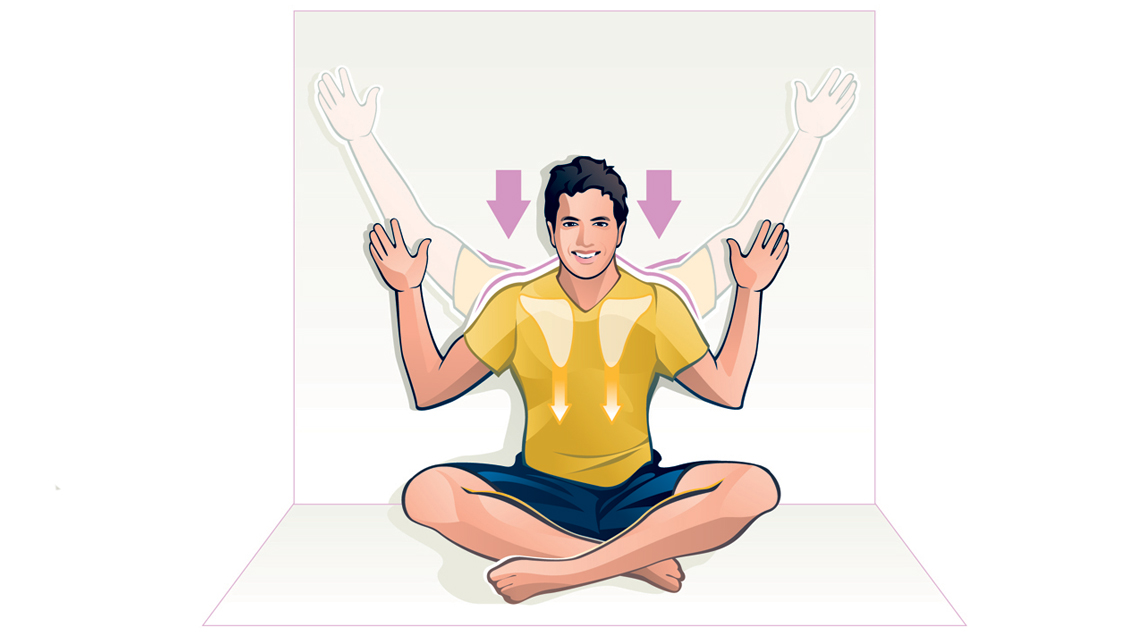Our shoulders carry the weight of the world. They help us perform a wide range of movements, from everyday tasks like writing and cooking to more specialized activities, such as rowing a boat or throwing a ball.
To accomplish everything we ask of them, shoulders require a complex structure with many moving parts. Each shoulder features four joints, three bones, and a combination of more than 20 muscles, tendons, and ligaments encased in a thin connective tissue called fascia.
In addition, further muscles in the neck, back, torso, core, and even hips assist movement at the shoulder joint.
Yet despite their essential role in our lives, our shoulders get surprisingly little attention — until a problem occurs, that is.
And problems do occur. These joints are prone to wear and tear, which can lead to shoulder pain, immobility, and injury. Up to 26 percent of U.S. adults are nagged by shoulder issues.
Most troubles fall into one of four categories: dislocation, bone fracture, tendon inflammation and tears, or arthritis. Dislocations and fractures are typically caused by a fall — often sports related. Tendon inflammation and tears can result from a sudden injury or from long-term overuse, while arthritis typically emerges during middle age, with pain worsening over time.
Even sitting at a computer for long periods can cause shoulder pain, especially if you don’t watch your posture.
If you’re experiencing shoulder issues, don’t despair: There are steps you can take to alleviate pain, immobility, and other complaints for the long haul. And for those who haven’t been hit with shoulder dysfunction, paying attention to the health of these joints can prevent some issues from even starting.
In either case, you’ll be rewarded with better movement, health, and quality of life.
Anatomy of the Shoulders
“One way to think of the shoulder is as a bridge between the arm and body,” says Mark Schneider, CSCS, a Minneapolis-based strength coach specializing in injury rehab and pain management. The shoulder itself moves via the interactions of four joints. These joints are supported by numerous muscles, bones, connective tissues, and fascia.
Muscles of the Shoulders
(See corresponding numbers in illustration below.)
- The Rotator cuff is a group of muscles and tendons that keep the ball-and-socket joint of your shoulder in place. It also allows for a wide range of movement, including internal and external shoulder rotation, and raising the arms to the side (abduction). The muscles of the rotator cuff include subscapularis, infraspinatus, teres minor, and supraspinatus.
- The Deltoid is a triangular muscle that covers the front, side, and back of the shoulder’s ball-and-socket joint. It attaches to the top of the shoulder blade, the side of the collarbone, and the side of your upper-arm bone. The muscle itself has three heads: the front (anterior) head helps move your arm forward; the side (lateral) head helps move your arm out to the side and overhead; and the rear (posterior) head moves your arm backward.
- The Shoulder girdle is a group of muscles that connect to your trunk and support the shoulder. Muscles include the rhomboids, trapezius (“traps”), pectorals (“pecs”), latissimus dorsi (“lats”), serratus anterior, and sternocleidomastoid (“SCM”).
Joints of the Shoulders
- The Sternoclavicular joint, or SC joint, is located where the breastbone (sternum) and the collarbone (clavicle) meet, at the base of the neck, in the front of the body.
- The Acromioclavicular joint, or AC joint, is where the collarbone and shoulder blade (scapula) connect at the top of the shoulder.
- The glenohumeral joint, or GH joint, is the central, ball-and-socket joint of the shoulder. It’s where the ball (head) of the upper-arm bone (humerus) rests inside the socket of the shoulder blade.
- the Scapulothoracic joint is found where the shoulder blade slides against the rib cage in the back of the body. It isn’t considered a true joint because it doesn’t have a synovial membrane, which provides lubrication by producing synovial fluid, and doesn’t have ligaments that connect to the bone.
Shoulder Smarts
While it may seem the odds are stacked against shoulder health, there are many things we can do to increase our chances of avoiding problems. The following strategies can help you keep your shoulders healthy for life.
Perfect Your Posture
The first step in supporting your shoulders is to pay attention to your posture. “We spend a lot of time with our shoulders rounded forward and rotated in toward the chest,” Bowman says. This strains the muscles in the back of your neck and shoulders and may pinch the tendons in the rotator cuff, causing your shoulder to become tender and even inflamed.
Counteract that hunched-over position by tuning in to your posture throughout the day. “Home base is what is comfortable for you, often with the shoulder sitting tall with a long spine,” Henjum advises. She suggests aligning your head over your hips and moving your shoulder blades back and down.
Sitting on backless chairs or simply scooting away from the backrest can also help by keeping your torso more active.
Don’t get stuck there, though. Stand up every 30 minutes and move around. Stretch your arms overhead, roll your shoulders in circles, clasp your hands behind your back and gently straighten your arms, and roll out tender areas with a foam roller or lacrosse ball.
Changing your position while sleeping is helpful, too, especially if you often wake up with a sore shoulder. “Swapping sides, as well as adjusting your position slightly to change the load on the shoulder, can help prevent pain,” Bowman explains.
(For more on perfecting your posture, see “Tips to Improve Your Posture“.)
Exercise for Strength and Mobility
Resistance training that strengthens the muscles and tissues supporting the shoulder joint, along with mobility exercises that specifically target the joints, are key for optimal shoulder function. “Exercise may be one of the few spaces where the joint is used through a full range of motion and under stress,” says Schneider.
Regular movement isn’t a cure-all, but it can go a long way toward protecting the shoulder. “If I trip and sprain my shoulder, that’s pretty hard to prevent,” Gray says. “But if I’m going to go play ball with my grandson, making sure my shoulder is prepared can help prevent pain and injuries.”
Strengthening and moving the shoulders isn’t enough; it’s also important to move them well.
“The first step is learning good form for common shoulder-loading activities, like quadruped positions, pushups, planks, and downward dogs,” Bowman says. “Most people are doing these moves in a way that keeps parts of the shoulders uninvolved and weak, and areas prone to injury under a heavier load than they should be.” Everything from hand and elbow placement to the movement of your shoulder blades can affect proper shoulder function.
Working with a fitness professional who can teach you the ABCs of shoulder form can help you strengthen and mobilize these key joints safely and effectively. (For more on proper exercise form for these moves, see our Break It Down department.)
Employ Self-Myofascial Release
Foam rolling and self-massage are techniques that can help with pain management. “They’re especially great for people who haven’t been paying attention to their shoulder health for a while and are starting to get back to regular exercise,” Henjum says.
Each option reintroduces gentle movement to the shoulder tissues, helping improve mobility and flexibility, release muscle tension, and boost circulation.
You can’t rely solely on massage and foam rolling to resolve your shoulder issues, though: It’s essential to pair self-myofascial release with exercise, she explains.
Load increases tissue tolerance and durability. Adequate strength, rest, and recovery are a constant balance for shoulder pain. (For more on self-myofascial release and self-massage, see “Be Your Own Massage Therapist“.)
Seek Professional Support for Pain
Sharp pain, new pain, or worsening pain in the shoulders calls for a visit to a medical professional. Conditions like adhesive capsulitis (frozen shoulder) and shoulder-impingement syndrome can worsen if stretches or exercises are done too vigorously, says Jon Frikken, PT, DPT, a physical therapist with Motion Minnesota.
Don’t wait too long to get help, either. “The patients who do the best, who recover in a shorter amount of time, are the ones who come in as soon as possible after getting hurt,” Henjum says.
When in doubt, aim to see a physical therapist if the pain doesn’t go away within two weeks. (For more on dealing with pain, see “How to Manage Chronic Pain — Naturally“.)
6 Exercises for Healthy Shoulders
Regular movement is key for prehabbing and rehabbing the shoulders. “There’s not much else that really addresses the root cause of the issue and can provide stronger, more injury-resistant shoulders going forward,” says Bowman.
Performing a combination of strength and mobility exercises can help you shore up weak spots in and around the shoulders and teach your shoulders how to move within their full range of motion. This will make everyday tasks easier and even improve athletic performance.
Incorporate the following strength and mobility moves from physical therapist Frikken into your routine up to three times per week. If you already have a strength routine, once per week will be enough, he says.
If shoulder pain prevents you from moving your arm or causes pain at night, seek medical assistance before performing these exercises.
Turkish Get-up
This exercise strengthens the stability of the shoulder in multiple directions.
- Lie on your back with your right leg extended and angled away from your body, right arm out to your side, and left knee bent with left heel on the floor. Make a fist with your left hand and extend it toward the ceiling, keeping your shoulder blade down, or “packed.”
- Drive your left heel into the ground and press your right elbow into the ground as you begin to sit up, leading with your chest. Continue reaching your left arm toward the ceiling.
- Press through your right hand and drive your left heel into the ground to lift your hips off the floor.
- Sweep the right leg back and place your knee on the floor directly under your hip. Keep your chest up, shoulder packed, and spine neutral.
- Rise into a half-kneeling position. Then, pivot your right knee so it faces forward like your left.
- Drive your left heel into the ground to stand.
- Reverse the sequence step by step until you return to the starting position. Complete five sets of one to five repetitions per side.
Pushup
The pushup is a great all-around exercise for strengthening the shoulders, as well as the triceps, pectorals, and core.
- Set up in a high-plank position, with hands slightly wider than shoulder width, arms extended, and body straight from heels to the top of your head.
- Keeping your body straight and your head in a neutral position, engage your core and squeeze your glutes.
- Bend your arms to lower your chest toward the floor, making sure your elbows flare out no more than 45 degrees.
- Push back to the starting position without breaking the straight line from head to heels.
- Repeat the movement until you feel fatigued, but not burnt out. Do three sets.
- If you’re not ready for the full pushup, do this move on your knees, or elevate your hands on a bench, countertop, or wall.
Plank Y-T-I
“This move works the serratus anterior and deltoid muscles on the side holding the plank, as well as the rhomboids and trapezius muscles on the side that’s moving,” Frikken says.
- Set up in a high-plank position, with hands slightly wider than shoulder width, arms extended, and body straight from heels to the top of your head.
- Grip a light dumbbell (start with five pounds or less) in your right hand. Without breaking your high-plank position, extend your arm as though you were forming half of the letter “Y.” Bring your hand back to the floor before extending your arm into half of a letter “T.” Then, “I.” That’s one rep.
- Repeat the movement until you feel fatigued. Do three sets per side.
- Do this movement on your knees if you’re not ready for the high plank version.
Lat Eccentric With PVC
This move helps lengthen the latissimus dorsi muscles in your back. Tightness in these muscles can limit your range of motion in overhead, forward, and extension movements.
- Grab a PVC pipe and thread a five-pound weight plate on it.
- Lie back on a bench and grip the PVC with palms up, elbows straight. Lift both feet so your shins and thighs form 90-degree angles.
- Keeping your elbows straight and your lower back pressed to the bench, slowly lower the PVC pipe behind your head. Work within your current range of motion; you’ve gone too far if the movement feels shaky or uncomfortable.
- Reverse the movement to return to the starting position. Perform 10 reps.
Side-Lying Shoulder External Rotation
The side-lying shoulder external rotation is a staple for strengthening the infraspinatus, a muscle in your rotator cuff that’s key for shoulder stability.
- Lie on your left side and grip a light weight (five pounds or less) in your right hand, with your elbow bent 90 degrees.
- Keeping your right elbow bent, slowly raise your right hand until it points toward the ceiling. Reverse the movement slowly.
- Repeat until you feel fatigued. Do three sets per side.
Foam Roll Rotator Cuff/Latissimus Dorsi
“This is a ‘feel-good’ exercise for the rotator cuff and latissimus dorsi muscles up near our armpit,” Frikken says. The goal is to relax tight muscles that can limit shoulder mobility.
- Lie on your side with a foam roller in your armpit. Roll forward, backward, and side to side until you find a tender spot.
- From there, lift your arm up and down while you make tiny movements around that tender spot with the foam roller.
- Continue for one to two minutes and focus on relaxing that tender area. Switch sides.
This article originally appeared as “Soothe Your Shoulders” in the December 2022 issue of Experience Life.







This Post Has 0 Comments